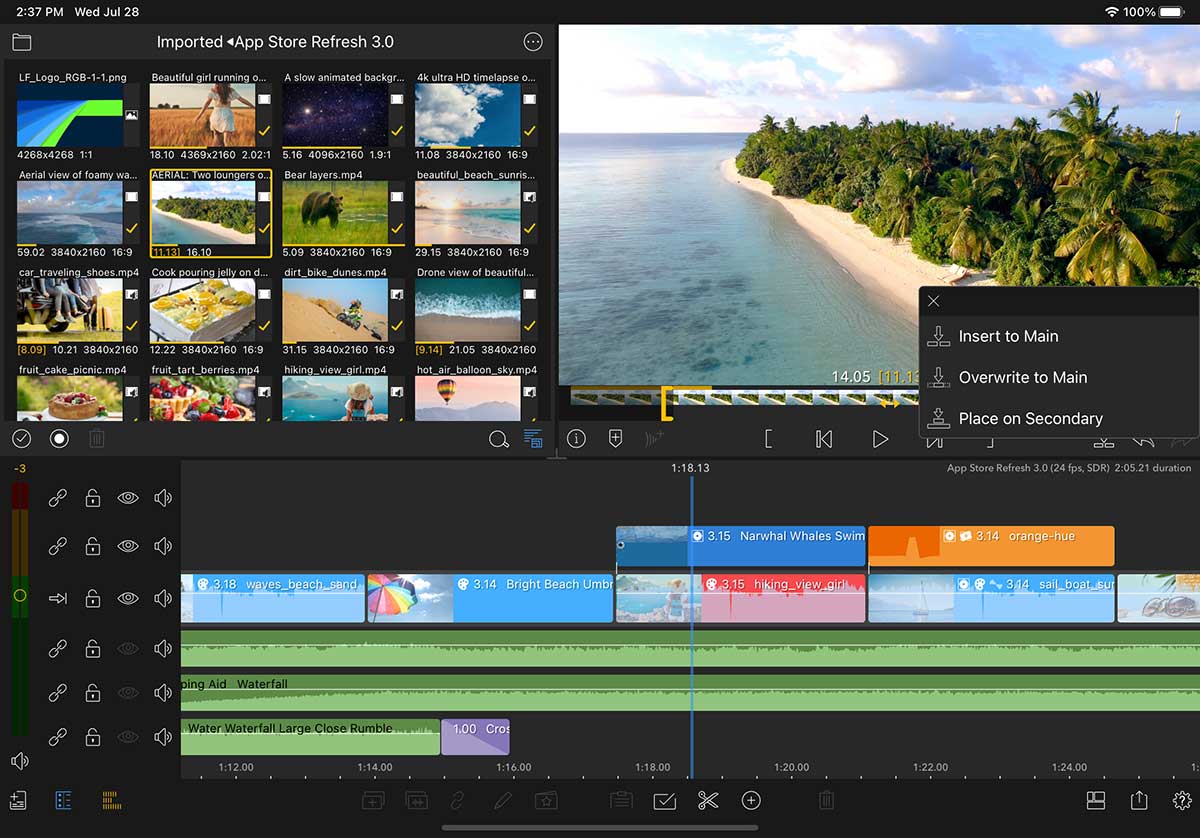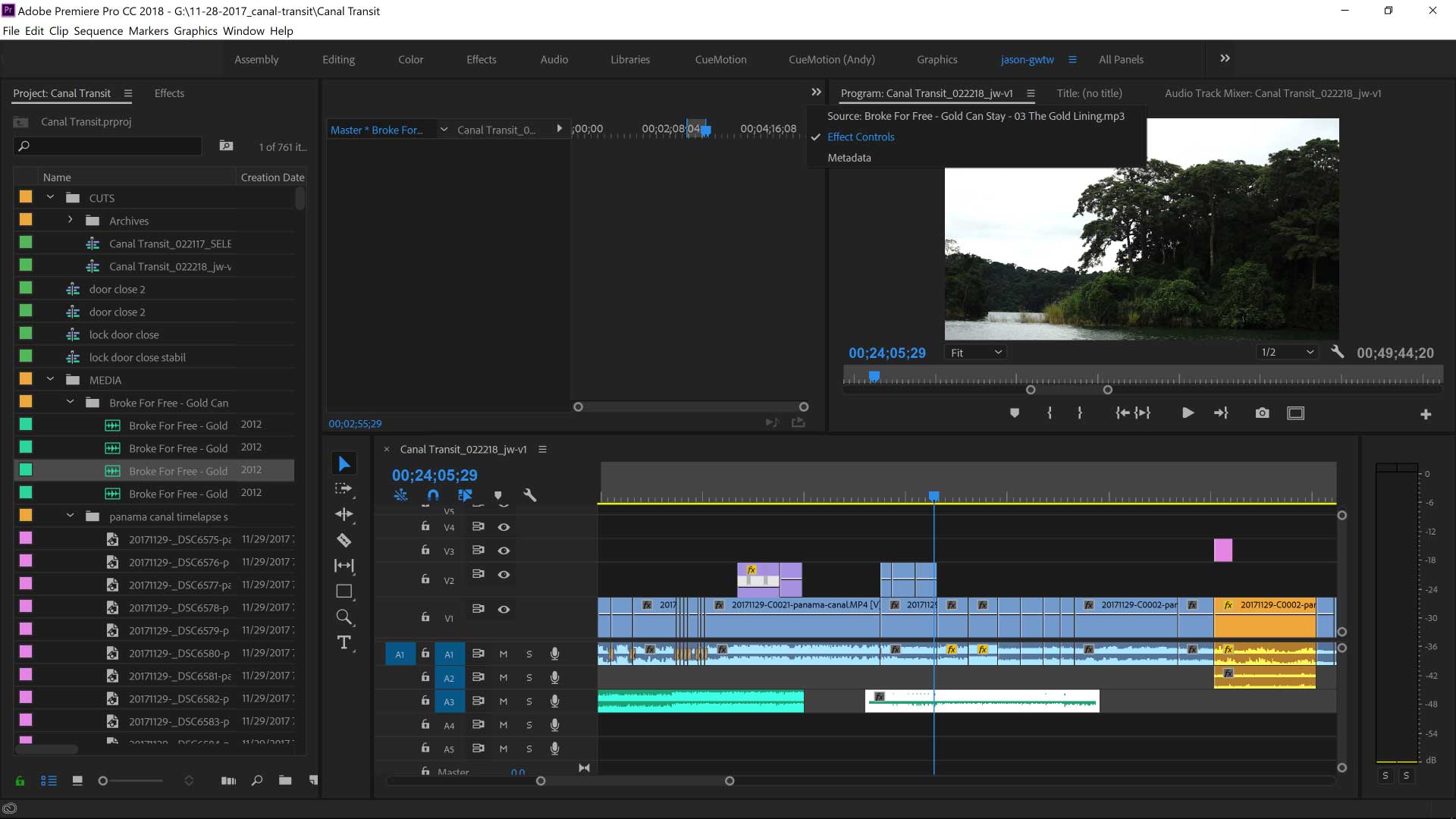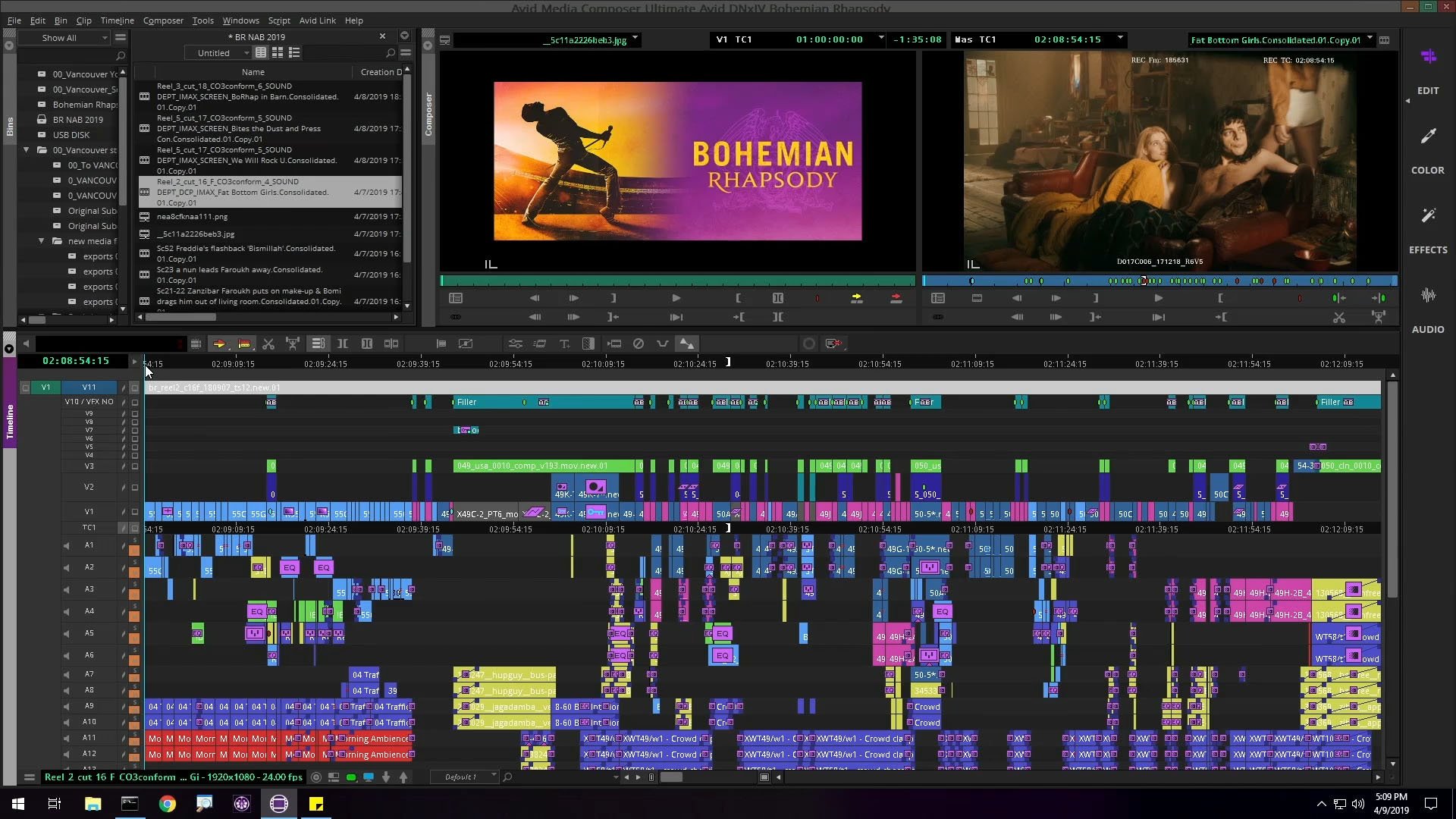Acclaim has been in the video production business in Cleveland for over ten years, and along the way we have used plenty of programs throughout the years to edit and color correct our footage. Many videographers, photographers, and social media managers have often considered learning video editing to supplement their abilities, because video has increasingly become the most popular media to consume online. Part of the reason for this rise in popularity is the advancement of smart phones and the capabilities of their cameras. Computers have also advanced incredibly fast over the last ten years and can now run very advanced video editing programs, and even 3D animation programs like Blender, on a reasonable budget.
While there are many programs out there, we wanted to talk about the 5 we have used the most over the years, starting with the most user friendly and ending with the steepest learning curves.
LumaFusion

Available on iOS and Android app stores, this is by far the best application for a smartphone to edit video. This single app caused us to never open CapCut or iMovie ever again, and the features it has available for just your phone are incredible. The best-selling point for this app is the fact that you can have up to 6 video channels playing at once and can edit them simultaneously. iMovie will only allow you to do two at the same time and requires you to export an mP4 and create a new project if you want a third video viewpoint to be inserted while losing the ability to edit the other videos individually.
Another cool feature in this app is the ability to import and export to cloud devices. This is an incredibly handy tool if you rely on storing videos in a cloud service and don’t want to eat up storage on your mobile device. As if these weren’t reasons enough to try it, the learning curve is incredibly low. It will not take you more than two YouTube tutorials over the course of an hour to pretty much grasp every feature this app has to offer. And for a one-time purchase of $30 it is hard to beat.

The only true downside to this video editing software is that the desktop version of it is nowhere near as good as other editing programs. If you have access to a decent desktop there is another software that can and will do a better job with editing your videos, but for an editor on the go who can’t bring a video editing computer with them wherever they go, this is hands down one of the most impressive editing apps on the market to date.
Final Cut Pro

This is where we get into the powerhouses of video editing. Final Cut Pro may have one of the easier learning curves on this list, especially if you are familiar with iMovie, but it does offer an impressive number of features. It is exclusive to iMacs and iPads, which is the largest downside to using this software. Having to buy a specific brand of computer or tablet to use one single video editing program is almost unreasonable, but apple products are incredibly popular around the world. This is not available on iPhone yet, but if it ever does become available for mobile phones, we will be the first ones to get it.
If you have ever used a Mac, then you will be right at home with Final Cut Pro. One of the key features of using Apple products is the interconnectivity of the devices. Airdrop is such an amazing tool for video editing. If I end up with an hour of footage and over two hundred photos I can skip the physical connection of my device. I can walk into my home, start to Airdrop my files in my kitchen, unload my work bag, grab a drink, and change out of my work shirt and when I sit down at my Mac in my office all the files will be downloaded or almost done downloading into a new folder on my desktop. It is hard to overstate the quality-of-life upgrade that Apple products have provided.
Now, depending on the specifications of your Mac, you can see extremely fast rendering and exporting times. The newer Macs have extremely powerful hardware and are optimized to edit 4K and 8K footage efficiently. Final Cut Pro also supplies a built-in audio editor and color grading tool that are mediocre. They are not amazing by any means, but it is nice that those tools are built in, because even buying Apple’s flagship audio editing software, Logic Pro X, would be another $300 on top of the $300 price tag for Final Cut Pro.

Apple has an infamous habit of being extremely unfriendly with other tech companies’ software and hardware. Apple has its own special encoding, its own special movie file type, its own special audio file type, and everything else under the sun just to make it harder for non-apple users to integrate Apple products with Non-Apple products. It’s infuriating. To add insult to injury there, the number of usable apps on the Apple store is severely lacking to Google or even using a Windows PC. The third-party support from Apple is laughable, and you will find out very quickly that Apple intends for you to use only Apple products, only Apple applications, and only Apple hardware as legally as possible.
Davinci Resolve

Now we are getting some serious editing power. Davinci Resolve is an absolute anomaly. The parent company, Blackmagic Design, makes some pretty impressive hardware from cameras to rigs, and designed a video editing platform to complement their video hardware. The best thing about Davinci Resolve is the price point. The basic video editor with all the features you could ask for is free. Let me say that again for the people in the back, the bulk of the features from Davinci Resolve are completely, unadulteratedly, incredibly free. If you decide to pay for the advanced tools and features, it will not be anymore expensive than Final Cut Pro at the exact same price point of $300. The color grading in the upgrade is nothing short of Hollywood levels of possibility, but it may not be what you need for your small business or personal YouTube channel. Remember what level you are editing at, and don’t overwhelm yourself with too many options too quickly.
The learning curve for Davinci Resolve is a bit more complex than Final Cut Pro, for the color-grading features and distinctive design, as a smaller company makes this program. However, if you are an experienced video editor, to some degree, then this will be an absolute miracle for you. If you are familiar with the general idea of editing a timeline in video editing software it will not take you more than a week to memorize the keyboard shortcuts, and to learn the placement of certain menus and features. It is baffling how much power you get from the free version, we honestly never upgraded because the free version was so in-depth and capable for everything we did, and the $300 price tag only gave us tools we had other programs doing already.

The worst part of Davinci Resolve is the steep learning curve for beginners specifically. If you have never touched video editing software, we recommend trying out some simpler programs like CapCut, iMovie, or Adobe Rush. The color grading in the pro version is slightly overwhelming, even for experienced video editors. Even the free version’s color grading is slightly overwhelming. Blackmagic gives you so many options right through the gate, but for someone who has never used a color wheel it can be almost nonsensical.
Blackmagic also designed the Free version to use a lot of hardware resources. It might be free, but your computer had better have a dedicated graphics card for transitions and effects and a lot of RAM to edit large projects. This is mainly because Davinci Resolve tries to do everything right inside the one single program. It’s a bottleneck of resources. With things like the Adobe suite, your computer is actually able to pause what you’re doing in Premiere, open up a separate window for audio editing in Adobe Audition, and then take you back to Premiere afterwards without your hardware trying to use every video editing resource and every audio editing resource all simultaneously. We are not saying you need a top-of-the-line gaming PC to utilize everything in Davinci, but at this point you do need to invest in some hardware that can handle what the program calls for.
The last thing we will say about Blackmagic is that their camera app for your smartphone is amazing as well for the same low price of, checks notes, free.
This is separate from their video editing software, but we will say we found it much more reliable to film consistent footage with their app over the iPhone or Samsung native camera apps. It provides you with a level of detail and settings that will blow your mind, and for zero dollars it’s worth trying out.
Adobe Premiere Pro
Now onto one of the biggest players in the game, Adobe Premiere Pro. This is Acclaim’s bread and butter, the program that is open most of the time when we make a video for a client. This has an extremely steep learning curve and is probably one of the worst pricing models on the market for video editors. If you want to pay for just Premiere Pro, it will run you almost $30 a month. That’s right, this is a month-by-month subscription service just like Wal-Mart is planning to do with their self-checkouts. Now, if you pay $90 a month you can get the entire creative suite from Adobe, which we will say is a steep price, but it includes everything under the sun in their catalog. They also have specific bundles coupling different programs for reduced costs, but honestly why pay $50-$60 a month for a couple programs, when $90 a month will get you every single program they make, which we want to state again is almost 25 separate video and photo editors, 2D and 3D graphic creation programs, animations, special effects and an entire myriad of other media production software that can lend themselves to every project you could conceive of having. It’s a lot.
Adobe also has a veritable library of plug-ins and third-party support for their products. Users can create plug-ins and sell them through Adobe. This means multiple video editors over the years have recognized a problem, created a solution, and then Adobe literally distributes the product for them to other users, usually for free or for an extremely reasonable cost. Remember how much we spoke on the creative suite having so many programs and functions? Well, Adobe is nearly untouchable in its compatibility and integration with its own products. It will let you pause Premiere Pro completely, reducing the resources it’s using to nearly zero, and open up another program like After Effects or Audition, where you can then edit just one single clip and have the effect saved and applied automatically in Premiere Pro. Once you close out of the other programs, your computer’s resources go right back to Premiere pro and apply the edits seamlessly. There is a reason this is the most used video editing platform in the world.

For better or for worse Adobe is constantly updating its products. This often solves many problems, but it also creates some as well. The subscription-based plan is just so awful, we can’t state that enough, and we are aware the world is heading to subscription-based everything, but we want to state our disgust outright. The last downside to Premiere Pro is the hardware you have may clearly not be enough. Something of this caliber will require a somewhat beefy computer with a good processor, a good graphics card, and lots of RAM. It’s not going to be optional at this point.
Avid Media Composer

Now we have the mother of all editing programs, the one used in almost every top-level studio for television and movies. Avid’s Media Composer is no joke and has top-of-the-line editing capabilities. Just to put this into perspective, The maximum price for this behemoth is $500 per year and can handle up to 99 video channels on the timeline at once. You will never use that many videos simultaneously. We can’t even come up with a good reason to ever use all 99 channels for videos all at once, even for a very specific style of montage, it’s just so many videos to handle and edit at the same time.
Avid has a cool integration feature for multiple users to edit the same project simultaneously and is clearly made for a Hollywood movie situation where multiple editors will be working on multiple sections across a large time frame simultaneously. If you have a studio with multiple editors this is the way to go, hands down. Avid also beats out all others on stability. You can push this program hard, extremely hard, and it is designed to handle anything you can throw at it. Multiple animations? No problem. Lots of color grading and video effects and transitions all within 3 seconds of each other? Easy as pie. Apparently, you must need 99 videos all being edited in the same timeline at once, and we guess it can handle that too. (Sorry, we can’t help but laugh at this)
Media Composer is a behemoth of editing software, and it’s not a good choice for most situations, honestly. If you want an introduction to editing, then go with Davinci Resolve. If you want more advanced editing software, use Final Cut Pro or Adobe Premiere Pro. If you have never edited a video, you should not touch this program for a hot minute. It will overwhelm you, and it will drain your wallet if you’re not already deriving an income from a reliable source.

You will need a commercial-grade level computer to utilize this program. It might be a computer you need to take a loan out to obtain, and it is meant to be used in a studio. This is not beginner’s software; it will require multiple years of experience in video editing and an incredible investment in hardware that can effectively run Avid’s Media Composer. You have been warned. Fortunately, Avid offers versions of its Media Composer to ease you into using it. They have a free version, which honestly is not as good as Davinci Resolve so just use that, and a medium-level price plan for the same cost as Premiere Pro with nearly identical features but less community support with plug-ins and transitions created by the community.
So, What Do You Use?
If you are a beginner in video editor stick with iMovie, CapCut, or spend the $30 on LumaFusion and get your hands dirty, there is no need to be spending hundreds of dollars on equipment and programs if you are just starting out. If you have a little experience and a mid-level computer, nothing fancy, try Final Cut Pro or Adobe Premiere. If you already put the downpayment into an editing PC and want to explore a more heavy-duty program, try Davinci Resolve’s free or paid version. If you have an obscene amount of money lying around, and a profession studio where you film commercials for TJ Maxx then you should probably hire an editor and get Avid Media Composer Ultimate.
We are poking fun at Avid, but it really is an industry standard that requires a large sum of capital to use effectively and is meant for an extremely large operation. Their free and mid-level versions are clearly outclassed and there is almost no reason to use them over their counterparts. Honestly, if you have a newer model of Mac and you have run iMovie for quite a long time Final Cut Pro will be the most intuitive and easy to grasp with a lot of features. If you have edited in CapCut for your client’s TikTok videos, then maybe upgrade to LumaFusion to get a lot more features unlocked and to have a powerful mobile editing software in the palm of your hand. If you have a decent Windows computer at home and want to get into video editing for the first time, try Davinci Resolve and watch 5-6 tutorials on YouTube to learn the ins and outs of it.
Where you are at in your editing journey is important to remember, and technology will change fast like it always does, so be ready to pivot in the next few years. We here at Acclaim like to keep up on important technological changes and the newest programs. Call us anytime to pick our brains and see what we think the future holds or ask us about video production and where it’s going in the next decade or so.